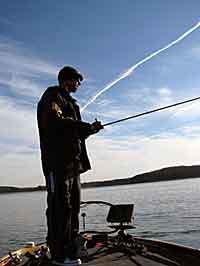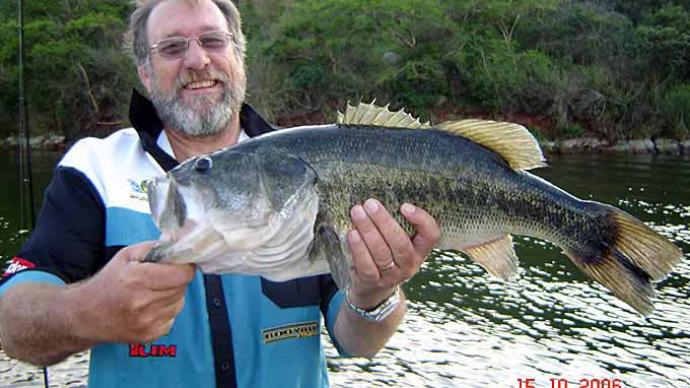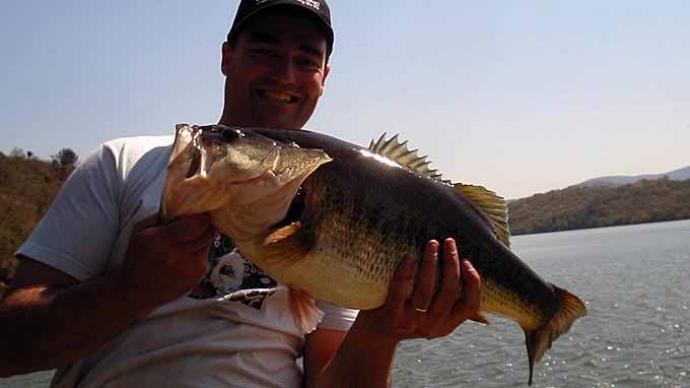
This is still probably the most misunderstood type of fishing out there. We've all been brought up with the notions of casting to visible cover. This makes non-visual targets difficult to fish for the average fisherman.
To me, anything deeper than 10 feet can be considered deep. As deep as I like to explore, it is around 50 to 60 feet under most conditions, although I've caught bass as deep as 80 feet (Lake George).
Remember the commandment. Also, remember the difference between structure and cover. Cover is some physical object separate from the actual bottom contour. It is often mistaken for structure.
Structure is the actual bottom contour (breaks, drops, humps, etc.) Think of structure as the highways and roads bass use to travel and migrate from one place to another. Think of the cover as rest stops or restaurants between these highways.
The presence of cover on some form of structure is the magic mix or what we call the sweet spots. Knowing that structure provides the highways for bass migration, you can see how important they are in the seasonal movements of bass.
SHORTCUTS TO FINDING PRODUCTIVE DEEP WATER STRUCTURE - The equation to finding an excellent deep water structure is as follows: Home Work + On The Water Fine-Tuning = Sweet Spots
Homework
Most of the shortcuts to finding a deep-water structure occur long before you get to a body of water. I can say that as many as 75 percent of the very successful deep water structure areas I have found over the years have been found at home looking at the map. My first Red Man wins on Lake Champlain. My second-place finish at Lake Toho. Contour maps provide the information needed to narrow your search.
The contour map is your road atlas in keeping with the highway analogy I made earlier. We can cut our search in half by going back to one of the commandments, seasonal pattern, and water types. Seasonal patterns are vital in figuring out the types of deepwater structure the bass will use.
In a perfect world, we can base a bass's entire life cycle on knowing two areas: Their spawning areas (flats) and their wintering areas(deep water vertical break areas). The structure breaks that connect these two areas are their migration highways. All you need to do is figure out where they are along the road.
Here is a general seasonal outline: The bass winter in the deepest water/vertical break areas (main lake). In the early spring period(pre-spawn), the bass begin their movements toward spawning flats and creeks. They use main creek channels or the main lake drop as their route. They stop at main points and humps first, then secondary points, to the spawning grounds. When the spawning ritual is complete, the head back out the same way stopping at secondary points than main points and humps, summer fish tend to scatter throughout the system, but a majority can be found along with the main deep water channel areas. They will again move shallow in the fall using the same points and humps they did before to feed up for the winter. They are heavily in tune to bait fish at this time.
In that entire seasonal plan we just discussed, the bass have use structure, either main channel, secondary creek channels, ledges, or breaks. The key areas are anywhere these channels intersect with something - a point, hump, landmass, or anywhere they make a dramatic turn or bend. These are the type of areas I am looking for.
I use different color pens to circle potential areas on the map. For example, I will circle deep wintering areas in a blue pen. I will circle the main points in black. And I will circle secondary points in red. I will then shade in spawning areas with a green pen. I also like to use multiple map sources and cross-reference them. No two maps are the same.
On The Water Fine Tuning
After all your homework has been completed, it's time to fine-tune the spots.
When I arrive at the lake and get into the area I have circled, I will fast idle the area in a zig-zag pattern. I am keeping a constant eye on my electronics. I am looking for any irregularity of signs of activity, such as cover on the bottom(brush piles, weeds) or pods of bait that will appear as black clouds.
I will keep zig-zagging up and down the potential area until I find something I like. When I do, I will throw a marker buoy on the area and continue to circle it to establish my boundaries. If I see something else or find a definite end to something, I will drop a second buoy.
Now finally, we get to make a cast. Using a search type of bait (crankbait, Carolina rig, heavy jig), I begin to fan cast the entire area. I am trying to establish contact with the bottom, cover, or near the bait.
The transmission that the search bait gives me is critical to the search. I can now find that lone brush pile or that section of rock or that one area where the channel bends. I am keeping a close eye on my depthfinder, points of land, and my marker buoys.
When I do catch a fish or hopefully multiple fish, I hit the quick button on my GPS unit, and I will immediately jot some notes down on my map such as GPS number, water depth, temperature, clarity, wind, or anything. Before I leave, I will make visual notes of land points if possible and try to triangulate points to help further find the sweet spot when I return.
Deep Structure Basics
There are also some general guidelines for deep water structure. During active feeding periods, such as low light, rain, wind, the fish generally move shallower and hold looser to cover. During high pressure or under adverse conditions, the bass tends to be a little deeper and tighter to cover.
Structure with complex type cover is better in the spring and late fall (shell/rock). Structure with soft type cover and current structure areas are better in the summer. Structure areas with more vertical breaks are better during the winter periods.
Generally, the same sweet spots on structure tend to produce over and over each year.
A thin echo bottom line on your depthfinder represents a hard bottom. A thick echo represents a softer type bottom. Turning the gain up on your depthfinder will enable you to find hard bottom/soft bottom areas and the thermocline.
Special Note: The drop shot technique is dynamite on deep structure, especially in clear, heavily pressured places.




